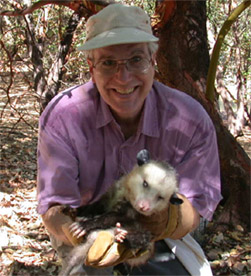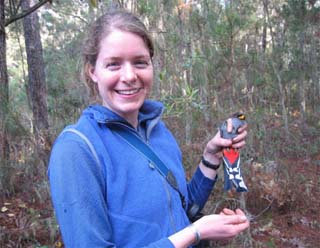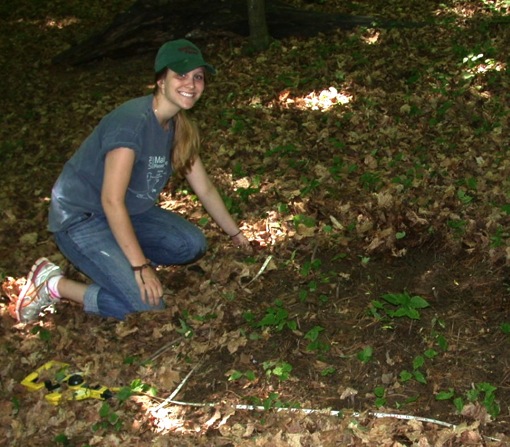|
|
|
|
|
 |
||
| Since 1978 the parasite research lab has always included an active group of graduate and undergraduate students and lab guide Dr. Joseph Schall. The photo shows the group in April 2014, all in our official lab t-shirts, including (from left) then graduate student Allison Neal (with the phylogeny t-shirt), then undergraduates Leslie Barnard, Max Ross, and Erin Keller, and Schall. Allision drew the great life cycle of P. mexicanum on the latest edition of our shirts. Max now is a technician in a biology research laboratory and plans on graduate school, Leslie is in a graduate program in public health at Tulane, and Erin is now a graduate student in the Biology Department. | ||
 |
Jos. J. Schall Professor Emeritus of Biology University of Vermont e-mail Prof. Schall |
|
Jos. J. Schall joined the faculty of the University of Vermont in 1980, and retired to Emeritus status in June 2014. He received his BS from Penn State, the MS from the University of Rhode Island, and the Ph.D. from the University of Texas. His interests in graduate school were community ecology and geographic trends in species richness. He conducted field work in the diverse Cnemidophorus lizard asemblage in the desert of SW Texas. Some of this work was published with his mentor, Eric Pianka. Schall's interests then shifted to parasites, and he was awarded an NIH individual postdoc at the University of California, Berkeley, where he worked with noted parasitologist John Simmons.
Since 1978 he has conducted a long-term study of the malaria parasites of lizards (in both the lizard and insect vector) at a site in northern California (UC's Hopland Research and Extension Center field station), and several Caribbean sites, including a long-term study on the tiny islands of Saba and St. Martin and the LTER site at El Verde in Puerto Rico. A team of researches at the University of Puerto Rico is now continuing that project, using in part the data generated during those early years of study. A study in Sierra Leone, west Africa, while productive, had to end because of civil war. His current work centers on the biology of another apicomplexan parasite, Monocystis of earthworms. In a break from studies on parasites, he worked with graduate students Denise Dearing and Steve Ressel on diet selection by herbivorous lizards on small Caribbean islands and with graduate student Diane (Cannon) Faile on the nesting behavior of the Pelagic Cormorant.
Schall has been honored by the University of Vermont with the two highest awards for teaching excellence, and the university's highest award for research excellence. His research was continuously funded for more than 30 years by the NSF, and by the Morris Animal Foundation for studies on avian malaria parasites. His work has resulted in more than 90 publications in major scientific journals. Although "retired" from active faculty duties, he continues his research and student mentoring. |
|
 |
Ellen Martinsen, Ph.D. Research Associate National Zoological Park, Washington Adjunct Assistant Professor, Department of Biology, University of Vermont e-mail Ellen |
Ellen Martinsen has been an avid ornithologist since the age of eight, when she began working with a local wildlife rehabilitation center. Ellen received her BS in Biology from the University of Vermont in 2000. After a few years working as an environmental educator, she returned to the university to pursue the Ph.D. and competed the degree in spring, 2009. While a graduate student she was named the outstanding Teaching Fellow of the year and was honored with the EPA STAR Graduate Fellowship for three years of research on malaria parasites. In August, 2008 Ellen was presented with the prestigious American Ornithologists Union Nellie Johnson Baroody Award for the outstanding student presentation at the joint bird biology meetings in Portland, OR. She then received both a prestigious National Science Foundation Postdoctoral Fellowship and a Smithsonian Postdoctoral Fellowship to work with the avian malaria team at the National Zoo. While there she received a Morris Foundation research grant. She is now a collaborator on a large NSF-funded project on the birds of SE Asia, being the parasite expert on the project. Ellen divides her time between UVM where she is an Adjunct Professor and the National Zoo, and has rejoined the malaria laboratory here to do research and mentor students. Ellen studies the biodiversity of avian malaria parasites of throughout the USA and several international sites (the photo shows her in the Dominican Republic with a friend). She combines study of morphological traits with modern molecular techniques and phylogenetic analysis. Ellen has sampled >4200 birds of over 230 species, and has sequenced hundreds of infections of Plasmodium, Parahemoproteus, Haemoproteus, and Leucocytozoon. The diversity of birds included in Ellen's study is thus very large. The data are analyzed to compare morphological vs. molecular definitions of taxa, to understand host range and possible host switching, and to define the true diversity of the parasites. Ellen also studies the overall evolutionary history of the malaria parasites, using multi-gene approaches. Ellen's publication in Molecular Phylogenetics and Evolution, presents a large phylogeny based on four genes from the parasites' three genomes. The result finds that major clades are associated with vector shifts into different dipteran families. Two other publications have appeared in Parasitology. The first (in collaboration with Ilan Paperna of Hebrew University) focuses on species concepts as applied to malaria parasites. Species identified by morphology are compared using genetic distance and phylogenetic analysis. The second asks if the current subgenera of malaria parasites are monophyletic groups. Another publication, in Journal of Wildlife Diseases presents a survey of the avian malaria parasites in California birds. Ellen's most recent paper showed that Plasmodium, long thought to be absent from any mammal hosts in the Americas, and absent from any deer world-wide, is present in our White-Tailed Deer (WTD). She found two diverse lineages, probably two species, that infect WTD all over the eastern USA. The parasite is common in WTD, with prevalence reaching a quarter of the deer infected at some sites. Ellen was able to date the divergence of the two lineages to about the time the WTD evolved from its ancestor that had traveled to the Americas via the northern landbridge. This paper, in Science Advances caused something of a sensation, appearing in hundreds of news and science websites around the world. A short video on the study appeared on the popular science website IFL Science, and was viewed 1.5 million times over the next 24 hours! Ellen's current research is on the malaria parasites of endangered birds and the diversity of parasites in the birds of Borneo. |
|
 |
Erin Keller Graduate Student University of Vermont e-mail Erin |
| Erin was a Biological Sciences BS major and a student in Schall's Honors section of introductory biology during her first semester. She was intrigued with the sections of the course dealing with pathogens and that led her to read over the publications on the lab website. At the very beginning of her Sophomore year Erin showed up in the lab ready to join in the research projects. Erin quickly became a valuable member of the lab group, first helping Max Ross, a Senior Undergraduate Research Student, with his project on the population generics of the sand fly vector of P. mexicanum, and then was lured into the Monocystis project. For two summers she worked more-or-less full time in the lab and field on that study. Erin received a summer research fellowship awarded by the university, a very competitive honor. Erin was named one of the top five graduating seniors in the Biology Department and awarded the Phi Beta Kappa honor as well. After graduating, Erin wanted to finish her research on Monocystis and so is now a graduate student in the department, working on her MS degree. Very good news for us! Erin discovered a new species of Monocystis in an invasive Asian earthworm, Amynthas agrestis, and began a study of the life history of the parasite -- the most detailed for any parasite in the genus. The study required both dirty fingernail ecology in the field, a great deal of work on the microscope counting parasites, and lots of molecular study of both parasite and the worm host. There are about 15 earthworm species in Vermont, so Erin became an apprentice with UVM's earthworm and soils expert, Dr. Josef Gorres of the Plant and Soil Science Department, to learn how to collect and identify these amazing animals. The picture shows Erin collecting worms in a standard 1 m x 1 m plot. Dr. Gorres lured Erin into yet another study on the population genetics of the worms to determine if two species of Amynthas are parthenogenetic. Thus, Erin's work covers the population genetics of the worm, the life history of the parasite, and she will also get to describe (and name!) the species she discovered. Outside of her academic activities, Erin is an avid runner, and has competed in many races, including the infamous Spartan Beast 13 mile obstacle course. Those kind of races prepare her well for the long haul in doing research that requires so much stamina! During the Fall Semester of her Junior year she studied in Norway where she learned the language. | |
 |
Samantha Connolly Undergraduate Student University of Vermont e-mail Sami |
| Sami is a Biological Sciences major, and has started her second year at the university. She began working in the lab during her first year at UVM, and was a real employed scientist this past summer thanks to funding provided by Dr. Josef Gorres in our Plant and Soil Science Department. Sami's interests are very broad, spanning ecology, plant biology, and genetics, and therefore it was not difficult to convince her to work on a variety of projects in the lab. To get a good handle on the Monocystis parasites, it is necessary to understand the biology of the earthworm hosts. Sami has become very good at finding earthworms (of the right species!), and extracting tissues and the parasites. But, Sami's love now is the population genetics of three earthworm species. She has been characterizing panels of microsatellite markers for our common nightcrawler Lumbricus terrestris and two jumping worm species in the genus Amynthas. Working with graduate student Erin Keller (who has collected a large sample of L. terrestris from many sites), they are genotyping many worms to get a handle on the genetic diversity and spatial structure of the earthworms. When not working in the lab, Sami has many outside interests including some kind of supposed athletic activity that involves beating people up (they call it martial arts?), traveling, and volunteering both on campus and in the community. | |